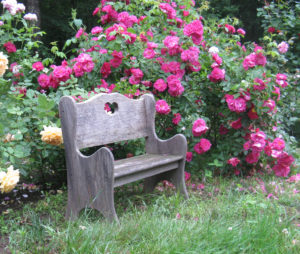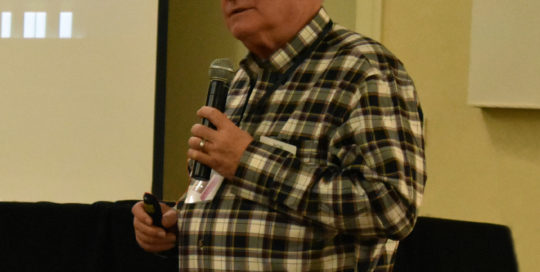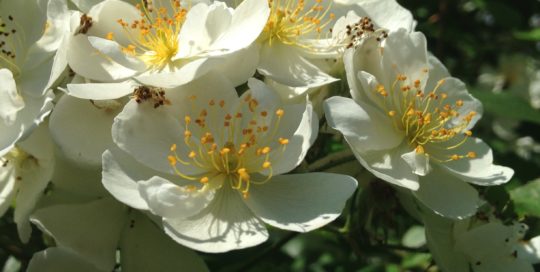Fertilizing in the Rose Garden
Views: 1737

A question about fertilizing
Ask ten rosarians how they fertilize, and you will receive ten different responses. I have my own unique and quite varied way as well. I had initially decided I didn’t want to write any extensive articles on fertilizing, because anything I may say may further cloud an already varied and complex subject for rose gardeners. But, recently a fellow rosarian sent me an email looking for advice on fertilizing. There were some statements in his email that I thought were not quite right, and it ignited a need for me to not only respond to his inquiry, but share some thoughts here as well.
What I do when fertilizing my roses
What do I do what I fertilize my roses? Well, a lot depends on what stage my roses are at. The stage that any one rose in my garden could be at is as follows: 1- newly-germinated seedlings; 2 – young seedlings and rooted cuttings; 3 – containerized small roses; 4- containerized full-sized roses, in-ground small roses, and in-ground full-sized roses. I know that this may seem like a lot of different types, but when you are hybridizing roses, testing them, and growing them to full size for as long as I have, you would understand why I have so many different ways. I usually have many roses at every stage in my garden, while the average rose gardener usually has two – in-ground roses that are either small (miniature/miniflora) and full-sized roses.
Information on fertilizers
The amount of information that is available on fertilizing fills volumes of books. I would only like to concentrate on the basics, and what I personally do. I’ll leave the heavy scientific explanations as to why things do what they do to the experts out there. For those wishing to delve further into more in-depth information on fertilizers, there is no shortage of information on the internet.
Know the pH of the soil in your garden
One of the most important things to know about your garden is the pH of the soil. If you do not know the pH of your soil, you should take steps to find out. There are many ways to do this – from at-home kits to sending soil samples to a lab for analysis. Your pH level should be in the 6.0-6.5 range. Going beyond this range in either direction will limit your plants ability to process the necessary nutrients that they need. If you find a need to raise/lower the pH in your garden, you should contact your local Consulting Rosarians and Master Gardeners for more information on the best way to accomplish this.
Timing of fertilizing is important
The timing of fertilizing your roses is very important. Plants need Nitrogen, one of the basic elements supplied by fertilizers. Nitrogen moves through the soil quickly, and the soil needs to be above 70 degrees in order for the plants to take up the nutrients. If you fertilize before it is warm enough, you risk losing the chance for the plants to utilize the nutrients when you make it available.
You also need to stop fertilizing late in the season. Plants need to slow their growth rate late in the season to get ready for the winter. Any new growth that may occur by fertilizing late in the year doesn’t get a chance to “harden off” before the freezing temperatures set in for the winter. When this happens, the energy expended by the plant to send up this new growth is wasted. Here in Southern New England we fertilize from May through September. You should contact your local Consulting Rosarians for the best time to fertilize in your area.
What is in fertilizers?
All fertilizers are made up of percentages of Nitrogen (N), Phosphorus (P) and Potassium (K). These are the macronutrients that make up fertilizers. The percentages are listed as numbers in the following order N-P-K on the label and/or packaging of all fertilizers.
Note: there are also micronutrients that are in many fertilizers, but not all fertilizers have micronutrients. These micronutrients are very important to the health of your roses. If a fertilizer contains micronutrients, they are listed as well on the label/packaging. The percentages of micronutrients and macronutrients are listed by weight. Anything beyond these percentages is filler and has no value to the plants.
What the macronutrients do?
Nitrogen in a fertilizer promotes top growth and the “green” part of plants. Phosphorus promotes bottom growth in the roots, and Potassium promotes all around growth and intensifies bloom color. Roses need a well-balanced fertilizer with supplies of all three macronutrients. Most fertilizers sold at garden centers and online are appropriate for roses. They do not have to have the word “rose” in their name. But, to be sure they are appropriate for roses, you should verify the N-P-K ratio, and ask your local Consulting Rosarians if you are in doubt.
Note: fertilizers that are high in one of the numbers are specialized fertilizers and are used for specific purposes. A couple of examples are the bone meal (3-15-0) and triple phosphate (0-45-0) that I recommended to add to your planting hole in last April’s blog when planting a rose. The reason for adding bone meal or triple phosphate at planting time is that Phosphorus moves through the soil very slowly, and putting it in at planting time helps to insure it is available to the plants when they need it.
What fertilizer should you choose?
Many old-time rose growers will often answer when asked what they recommend for fertilizer with “the cheapest (10-10-10) that you can find”. While technically true, and I will agree that plants do not know the difference between organic and inorganic fertilizers (or know how much you may spend/not spend on fertilizers), there are differences in fertilizers in the micronutrients that are in/not in them. I will state that I have used many different fertilizers, both organic and inorganic, and they all worked well. There are many spirited discussions about organic vs. inorganic, what’s good/bad about them, and I recommend everyone their own research as to what will work best for them. The decision on what fertilizer one uses often goes hand-in-hand with the type of gardener that they are. Remember, there is not any “right” or “wrong” answer to what fertilizer you ultimately decide to use.
1- Fertilizing newly-germinated seedlings (my baby roses)
Newly-germinated seedlings can be fertilized after their first set of true leaves appear. I use an indoor water-soluble plant food such as Miracle-Gro® Indoor Plant Food (1-1-1) diluted to 1/10th normal strength. I give these seedlings a tablespoon weekly. As they grow, I increase this to two tablespoons weekly. My seedlings that are this small are usually in small fruitcups or plastic drinking cups and can’t take much more than this.
Note: these seedlings are just tiny babies, and the roots can “burn” if fertilized too heavily. There is plenty of time to let your babies grow and become full-fledged roses.
Time to move up and go outside
I generally set my newly-germinated seedlings outside once the temperatures are consistently over 70 degrees, the seedlings are 3”-4” tall, and are showing signs of vigour. At the same time as I put them outside, I transplant them in 4” containers. I replant in the 4″containers as I discussed in my last blog.
Getting acclimated to the sun
Note to people interested in hybridizing and rooting cuttings indoors: when you are planning on bringing out seedlings (or newly rooted cuttings) that have been inside for an extended period of time, be sure to acclimate them to the sunlight gradually over a period of a few days. This is done by allowing them only one hour of direct sunlight the first day, and increasing an extra hour per day until the rose can stay out in the direct sunlight indefinitely. The ultraviolet rays from the sun can burn the foliage if a rose is left outside too long before getting fully acclimated. For more information on getting newly-germinated roses to full size, go to the Rose Hybridizers Associations’ website – www.rosebreeders.org.
2 – Fertilizing young seedlings and rooted cuttings
Very young seedlings and rooted cuttings are roses that are in containers outside, and are between 4”-12” tall. They are taking their next steps towards becoming full-fledged roses. I fertilize my young seedlings and rooted cuttings with either fish emulsion (4-1-1) or a water-soluble fertilizer such as Miracle-Gro® (24-8-16) cut to 1/4 -1/2 strength. I give cup of fertilizer weekly to young seedlings and rooted cuttings. Like newly-germinated seedlings, the roots of these young roses and rooted cuttings are also small and tender and can be burned if too much fertilizer is used.
3 – Fertilizing container-grown small roses
In time, these very young seedlings and rooted cuttings will grow and need to be transplanted into one gallon containers. I transplant the roses into these larger containers as I discussed in my last blog. Rooted cuttings that are bought online from “boutique” nurseries usually fall into this category. I fertilize container-grown small roses with either fish emulsion (4-1-1) or a water-soluble fertilizer such as Miracle-Gro® (24-8-16) at full strength. I give them a cup weekly, and in time increase this to a quart every two weeks (or two cups weekly) as the roses become larger.
4 – Fertilizing container-grown full-sized roses, in-ground small roses, and in-ground full-sized roses
In time, full-sized roses will grow and need to be put into even larger containers. It is at this point I need to decide if I want to continue growing these roses in containers or plant them in the ground. Time is usually the determining factor, and it is not usually on my side. For those roses that I plan on keeping in containers for indefinite periods of time, I usually replant them in three and five gallon containers as I discussed in my last blog. These roses are in the containers for the long haul, and they need plenty of room to stretch their roots.
When roses get this big, I treat them the same way I treat the roses planted in the ground. They receive the same fertilizer once a month from May through September. The only difference between in-ground small roses (usually miniatures and minifloras) and full-sized roses (either in the ground or in containers) is that I fertilize the full-sized roses once a month with a complete dose of the fertilizer, and a half dose for the small roses. At this point, I do not exclusively use water-soluble fertilizers. I use what I have available. I do not rotate fertilizers, but I do tend to lean towards organic fertilizers to glean the micronutrients and organic matter that often accompany them.
A few side notes
Well folks, that’s my method for fertilizing. As you can see, it is quite varied and specific to the particular type of rose that I am fertilizing. A few things to note:
- Roses also receive nutrients from the organic amendments that are added at planting time. It is extremely important to add them when planting your roses. They will continue to receive benefit from these amendments throughout the time they are in your garden.
- There are many fertilizers that are “time release” and do save plenty of extra work fertilizing. Using fertilizers such as this are becoming increasingly more important as our lives get busier and busier. Be sure to consider them as well as time-savers in your garden.
Fertilizer Recommendations
- The PlantersPlace website is sponsored by one of the best time-release fertilizers on the market, Osmocote®. I was first introduced to Osmocote® through a rose that I bought early on. At the time, I did not understand the importance of fertilizing and the health if the roses I was trying to grow. However, there was a packet of Osmocote® that came with the rose, and through that small packet came an eye-opening experience of growth that screamed back to me that I REALLY CAN DO IT!
- Organic amendments such as alfalfa pellets, compost, etc. work, and work well. And, I highly recommend you consider using them. I have used them many times as supplements to the fertilizers that I have fed to my roses, and I have felt as though intangibles such as increased fragrance can be traced back to when I was using them. Experiment as you wish, but the importance of adding organics to your soil cannot be understated.
- Read and follow the directions that come with your fertilizer(s). Make sure that you understand the directions located on any fertilizer you may use. Every fertilizer product is different and damage to yourself or your plants may result with improper use/misuse.
- Write down these directions for future use. It saves time looking them up every time.
- One of my favorite things to do in the garden is to fertilize my roses. The intimacy through which I experience when I fertilize my seedlings and watch them grow is precious. They are my babies (both figuratively and literally) and watching them turn from small seedlings barely an inch tall to full-sized roses in the garden is one of the most satisfying experiences a hybridizer can have.
Epilogue
When I wrote this blog, I wanted to use one of my pens that hasn’t been getting much use. One of the first pens that I came across was a grey Wearever® pen that was purchased in a big lot of fountain pens at an antique shop. I fixed the bladder a couple of years ago, but I for some reason relegated it to the humidor that I use to store my pens, and hardly ever used it. I inked it up, and it promptly worked flawlessly. What a surprise when I found out that the pen has a fine point and not a medium point! I think that after I’m finished with this blog I may re-ink it with blue ink, relegate it back into service full-time and retire my gold Waldorf for a while.
I see online that my fellow society members in Rhode Island already have buds forming on their roses and expect blooms very soon. I’m jealous and still three/four weeks away from any buds/blooms on my roses. Roses in late April and early may in Rhode Island! My how things have changed with the current climate we find ourselves in?
Meet Andy Vanable
Andy's Recent Posts

The Rose-Growing World Loses an Icon – Bob Martin






